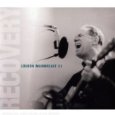Last night – Thurs, Oct. 29 – we went to see Richard Thompson and Loudon Wainwright III at the Vic(tory Theater) in Chicago.
It was an acoustic show, with both artists perform with guitar only solo, and a handful of songs (in two sets) together – once with Wainwright leading, the other playing Thompson songs.
Before I get into the body of the review, a comment on the crowd. Well, the doors opened at 6:30pm (for a 7:30pm show). We got there about 5:45pm and we were only about the 11th and 12th persons in line. I knew the show wasn’t sold out, and I was getting worried that we’d end up with a show where all 40 audience members gather on stage around the artists, like he was playing in someone’s basement.
My fears were unfounded – by the time the show was about the start, the mezzanine was packed – and, while I couldn’t see the balcony, I could tell it was being using (you’d see the stray hands sticking over the edge).
And the crowd – of the 500-700 people there, about maybe a half-dozen/dozen were less than 40 years old. Lots of white hair, long-haired 60s refugees, women in flowered Woodstock prints.
Before most concerts, you see everyone on their cell phone texting friends or updating their Facebook pages.
Here, they were reading the Chicago Tribune or a book/magazine.
Weird.
Loudon Wainwright III
Wainwright was up first (right on time: these guys are pros).
Remarkably unremarkable appearance. Blue plaid cotton shirt, dockers, tousled and receding gray hair. You could toss him a suburban backyard BBQ and he’d be anyone’s dad. Blend right in.
Wainwright was in part shilling is new album – Recovery – that is a collection of new takes of his old songs.
He also did a lot of topical songs – as he dubbed them, “New songs for the New Depression.” And he promised to keep these songs upbeat, because “I want to cash in on this depression!”. Cash for Clunkers, another song about Nobel-Prize winning economist Paul Krugman and so on.
You get the drift.
Wainwright is a great entertainer: snappy banter between songs, comments on the city, making lots of faces and contorting his body for emphasis during this songs. But in the end, it was fun but forgettable. I honestly can’t recall any of the songs’ music.
Richard Thompson
en.wikipedia.orgUnlike Wainwright, Thompson is a very imposing presence: Tall, angular, closely shaved gray beard and wearing his omnipresent black beret.
And when he plays – just him on a six-string guitar – it sounds like many instruments.
Thompson opened with When the Spell is Broken, an almost 20-year-old, typically dark Thompson number. But as he drove through it, he managed to maintain a pounding bass line while layering all sorts of twangs and pings on top of it.
Thompson had a number of extended instrumental portions in his songs over the course of the night, and he would inevitably get as much applause – in the middle of a song – for these acts of finger acrobatics as he did when the song ended. Remarkable.
My favorite? 1952 Vincent Black Lightning. From the 1991 (wow, has it been that long?) album Rumor and Sigh (arguably Thompson’s biggest commercial success), the song has long been one of my favorites. Great, zippy finger-strumming song.
But in concert – and I’ve now heard Thompson perform this twice – he really hits the accelerator: Fast and furious. Beautiful.
I went to the show for Thompson, and I was not disappointed. I could have taken hours more of him.
It was pouring when we got out the the theater, but who cares? Was a good night of excellent music and entertainment.



 I was just noodling around the web this evening, and I ran across a recent article about why (still!) Linux hasn’t really caught on for the desktop.
I was just noodling around the web this evening, and I ran across a recent article about why (still!) Linux hasn’t really caught on for the desktop.






